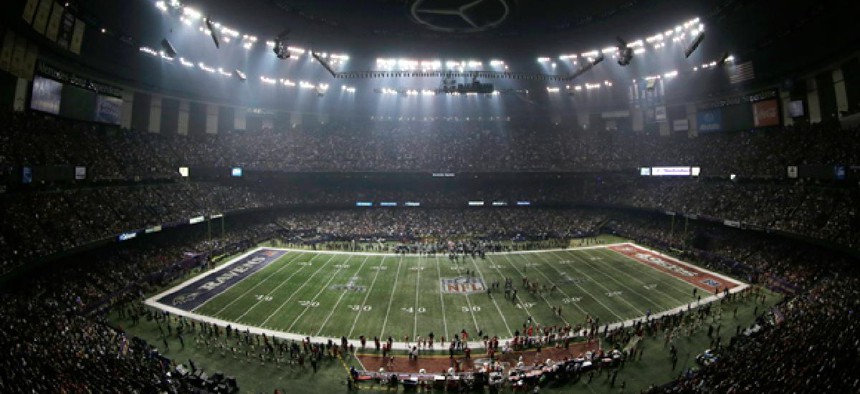Super Bowl blackout could energize a debate on power grid

Fans and members of the Baltimore Ravens and San Francisco 49ers wait for power to return in the Superdome. Charlie Riedel/AP
Improvements could resolve the issues that took out power during the game.
Questions remain over what caused the half-hour power outage during Sunday’s Super Bowl in New Orleans. What is clear is that advocates of improving the nation’s energy infrastructure see it as a metaphor.
“I think any of you who watched the Super Bowl last night know that energy is not only good, it's necessary. And whether it's keeping the lights on so that we can enjoy the game or whether it's keeping the lights on so that we can work, this is — this is essential to who we are as a prosperous nation,” Sen. Lisa Murkowski, the ranking member on the Senate Energy and Natural Resources Committee, said at a press conference to unveil an energy proposal on Monday.
If there's a silver lining to be found to the partial blackout, it's this: the way the stadium's electrical system worked, at least according to an early official statement, shows how improvements to energy infrastructure can contain damage.
“Power outages cost our country over $70 billion a year,” said Richard Caperton, an energy expert at the Center for American Progress. “Anything that draws attention to that problem and helps motivate people to deal with it is helpful.”
Minutes into the second half of the game, an electrical-load monitor sensed an “abnormality in the system," according to a joint statement from the management company of the Mercedes-Benz Superdome and the stadium’s energy supplier. The monitor then opened a breaker, cutting power to part of the Superdome "in order to isolate the issue.” That kind of fast response is a sign of things to come if and when the nation upgrades its energy infrastructure.
“I mean, in the past, there haven't been that many sensors out there, there haven't been that many ways to redirect things and control things and there also haven't been that many different resources, so if one power plant were to run into a problem, that was a major problem,” said Dan Delurey, the president of the Demand Response and Smart Grid Coalition, a trade association for providers of smart grid technologies.
The game, which drew an average of 108.4 million viewers, was another in a series of high-profile power outages during the last year. During Hurricane Sandy in late October, thousands up and down the Eastern Seaboard (and beyond) lost power for periods stretching from days to weeks. Lawmakers in Washington, D.C., found themselves hamstrung during this summer’s fast-moving “derecho” storm, which knocked out power throughout the Washington region.
The American Society of Civil Engineers gave the country’s energy infrastructure a D+ in an infrastructure report card released in 2009. The U.S. “quality of electricity supply” is ranked 33rd globally by the World Economic Forum’s 2012-2013 Global Competitiveness Report. Proponents say improvements to the nation’s infrastructure will create jobs.
Last year, President Obama called for repairing the nation’s infrastructure in his State of the Union address. “Building this new energy future should be just one part of a broader agenda to repair America’s infrastructure. So much of America needs to be rebuilt,” he said. The president’s next State of the Union address, set for Feb. 12, will set the agenda for the next four years. Obama's a big football fan; perhaps the Super Bowl outage will spur him to take renewed action on infrastructure.


